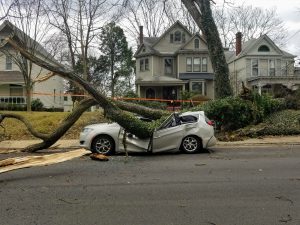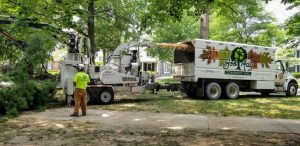How Do You Fix A Storm Damaged Tree In Louisville?

High winds and saturated soil typical of winter storms can cause tree roots to fail and branches to weaken. Limbs might be torn totally free during storms or a whole tree might fall, causing power failures, home roof leaks, as well as individual injury. Throughout winter, the load of ice and snow accumulations create failure of branches and even whole trees.
While it’s impossible to completely safeguard your trees and home from serious storms, you will find some fundamental procedures of winter tree care that may help decrease the danger of harm. The certified arborists at Bob Ray Co. Inc. are tree care specialists and can inspect trees for weak spots and risks that the untrained eye cannot detect.
Here are some basic tips from one of our certified Arborists who were recently interviewed about storm damage:

- Stabilize trees around the home by cabling them or tying them down, particularly those which you know have structural flaws like:decay Cavities, dead limbs (overhangs),splits,heavily used areas with compacted soil and injured roots,heavy horizontal limbs, Basal or crown rot; root decay.
- Call a Certified Arborist and have him do a quick inspection of your trees before the storm. This will allow you to take precautionary measures. Decaying and leaning trees ought to be pruned, staked or removed, particularly those threatening dwellings or utility lines. If they are not properly trimmed they can cause severe damage to your home and require renovation or roof replacement
- If your trees do get hit hard, think safety throughout the cleanup. The debris on the ground will not hurt you unless downed power lines are involved. It is what’s overhead that is harmful. Tension fractures or dead and broken limbs can come crashing down with very little warning.
- Be particularly cautious when working with chainsaws. If a badly damaged tree is still standing, call a tree service or tree care company. We have seen too many injuries with chainsaws and ladders.
- Patience can be a money-saver when dealing with ice or snow loads on trees. Wait until it melts and the weight is taken off to determine what sort of damage was done. Trees are resilient and are very effective at bouncing back.
- Plant native trees instead of exotics. Some varieties fare much better than others in storms, particularly trees with conical branching, those with strong branch connections and trees which are small when mature.
- There is strength in numbers. Trees planted in groups survive much better in high winds.
- Discover how to assess harm. Trees which have lost a few branches of substantial size but with trunks mainly intact most likely may be saved.



